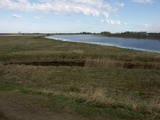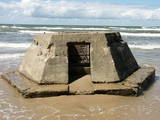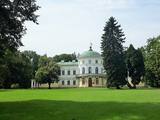| Nr | Nosaukums | Apraksts |
|---|---|---|
|
Viena no nozīmīgākajām pavasara migrējošo ūdensputnu atpūtas un barošanās vietām, kas izveidojusies pavasaros aplūstošajā Svētes palieņu pļavās un Svētes polderī. Aprēķināts, ka kopējais putnu skaits piemērotos apstākļos var pārsniegt vairākus desmitus tūkstošus īpatņu. Te pulcējas gulbji, zosis, griezes, garkakļi, dažādas plēsīgo un tārtiņveidīgo putnu sugas u.c. Ievērojiet putnu vērošanas ētikas kodeksu! |
||
|
No baterejas līdz mūsdienām ir saglabājušās dzelzsbetona dzota paliekas, kas ilgstošā vēja un viļņu darbības rezultātā, noskalojot krastu, ir noslīdējušas līdz pat liedagam. Interesants vēstures piemineklis, kura liktenis ilgtermiņā ir nojaušams – tas pazudīs zem jūras līmeņa.
|
||
|
Saaremaa salas galvaspilsēta. Populārs kūrorts. Baroka stilā celts rātsnams.
|
||
|
Atrodas Valmieras – Ainažu autoceļa (P 16) malā starp Matīšiem un Aloju. Iekārtota vecajā un atjaunotajā dzirnavu ēkā. Nedēļas nogalēs piedāvā izklaides pasākumus, klāj galdus un īrē telpas svinībām. |
||
|
Piemājas saimniecība nodarbojas ar augļkopību un biškopību! |
||
|
Dievnamam ir netradicionāls plānojums un izkārtojums: altāris atrodas vidū, bet kancele virs altāra. Baznīcai ir arī savdabīgs zvanu tornis ar 1634. g. lietu zvanu. Tagadējo koka interjeru veidojuši Rīgas amatniecības vidusskolas audzēkņi. Blakus baznīcai atrodas vecās baznīcas drupas un mācītājmuiža, kur 18. gs. nogalē par mājskolotāju strādājis Garlībs Merķelis, kurš Liepupē novēroto izmantojis savā nozīmīgajā darbā “Latvieši”.
|
||
|
Baisogalos muiža ir viena no senākajām muižām – saukta karaliskā, jo piederēja Lietuvas lielajam kunigaitim. Līdz mūsdienām saglabājušies greznie, vēlīnā klasicima stila (ampīra) muižas nami celti 19.gs. vidū. 12 ha ainaviskais Baisogalos parks izveidots 19.gs. pirmajā pusē. No ciemata puses uz muižu ved kastaņu aleja. No vārtiem centrālā aleja ved caur diviem līkumotām ūdens krātuvēm, pār tiltiņu ar lauvu figūrām. Aiz muižas dažādi koki aptver līkumotās alejas un šaurus parka celiņus. Abu parka aleju pusēs atrodas pa ūdens krātuvei, parka dziļumā – dīķis ar salu. |
||
|
Atrodams starp Rumbulu un Salaspili un veidots vietā, kur 2. pasaules kara laikā atradās vācu nacistu izveidotā koncentrācijas nometne. Atrodamas ziņas, ka tajā iznīcināja > 50 000 okupēto Eiropas valstu iedzīvotāju. Memoriāls totalitāro upuru piemiņai, kas ir viens no lielākajiem Eiropā (25 ha), tika atklāts 1967. g. To veido lielas skulptūras un to grupas - “Māte”, “Solidaritāte”, “Nesalauztais” u.c., kuras ieskauj „Ciešanu ceļš”. Memoriāla ieejas vārtu sienā ir izveidota tematiska ekspozīcija. |
||
|
Kultūras tūrisma cienītājiem šī ir viena no pirmajām vietām, kas jāapmeklē nacionālajā parkā. Nelielais ciems izvietojies Ūlas ielejas labajā krastā, kur cilvēki ir dzīvojuši jau akmens laikmetā, par ko liecina atsevišķi savrupatradumi. Zervinos atrodas liela meža masīva vidū. Ja uz to dodamies ar automašīnu, vienīgais „drošais” ceļš ved no Mančagires puses. Zervinos sākas ar grantētu lauku ceļu krustojumu, kura vidū slejas koka krucifikss. Te ir jādodas pa labi, kur redzamas simtgadīgas koka ēkas un sētas, kas saglabājušas veco plānojumu. Zervinos patiesi var iejusties 18. – 19. gs. laika dimensijā. Ne velti, šis ir viens no visvairāk pētītajiem Dienvidlietuvas etnogrāfiskajiem ciemiem. Dodoties tālāk, ir redzama Ūlas upe un tilts – laba un pat speciāli izveidota vieta, kur var uzsākt braucienu ar laivu. |
||
|
Krodziņš "Rūdolfs" atrodas Kokneses centrā, Kokneses muižas pārvaldnieka mājā, un nosaukts latviešu novelista Rūdolfa Blaumaņa vārdā, kas mācījies muižā un nodzīvojis tajā divus gadus. Latviešu virtuve: Rasols, siļķu salāti, pupiņu salāti, Valmieras salāti, sīpolu sitenis, cūkgaļas ribiņas, mājas kotletes, cepetis mārrutku mērcē, cepta akna, siļķe ar biezpienu, auzu pārslu kārtojums. Īpašais ūdens: „Krodzinieka šķēle”. |
||
|
"Pakalnieši" ir mājas siera ražotne, kurā top mīkstais siers ar vairāk kā 25 veidu piedevām, siera bumbiņas un citi piena produkti. Kā piedevas tiek izmantotas ne tikai ķimenes, bet arī, piemēram, apelsīnu miziņas, olīvas un valrieksti. Sieri tiek gatavoti ar rokām un no dabīgām izejvielām. Produkciju iespējams iegādāties uz vietas ražotnē, Rīgā - Imantas un Pļavnieku tirgū, Saulkrastos veikalā, Smiltenē, Valmierā, kā arī citās Vidzemes pilsētās. Piedāvājumā ekskursijas un degustācijas - zāles ietilpība līdz 60 personām, kā arī meistarklases ( līdz 20 pers.) |
||
|
1768. gadā celtais Siera namiņš, kas atrodas Kalnamuižas (Smiltenes muižas) teritorijā, ir vienīgais šāda veida industriālā mantojuma objekts, kas saglabājies Latvijā. Pirmajā stāvā te glabāja pienu un siera katlus. Uz otro stāvu veda kāpnes, kas nav saglabājušās. Otrajā stāvā kaltējās siers un šo procesu veicināja namiņa koka daļās izurbtie caurumi (siers vējojās). Kaut arī caurumu vietas ir aizbāztas, tās mūsdienās labi redzamas. Atrodas blakus Smiltenes viduslaiku pils drupām. Namiņš atrodas uz iznīcības robežas! Apskatāms no ārpuses. |
||
|
Zemnieku saimniecība Nurka atrodas Luitemaa dabas aizsardzības apgabalā Pērnavas apriņķī. Saimniecības komplekss, kas ir vecāks par 100 gadiem, ir atjaunots par mūsdienīgu brīvdienu māju ar visām mūsdienu ērtībām. |
||
|
Aptuveni kilometru rietumos no bijušās Vārnavas skolas meklējami “Rudzīši”, kuros saimnieko Ēvalds Pūpols ar ģimeni. Ēvalds Pūpols lielāko savas dzīves daļu ir nodarbojies ar vīnogu audzēšanu un jaunu šķirņu veidošanu. Paugurainā Sēlijas vaļņa mežu skautā ielokā ir izveidota skaista, ainaviska un iekopta vide dažādu siltummīlošo vīnogu audzēšanai dabā, kur gandrīz hektāru lielajā vīnkoku dārzā aug ap 80 dažādu šķirņu vīnogas. Šis dārzs (nogāzes vērstas pret dienvidaustrumiem) ir viens no Latvijā lielākajiem un šķirnēm bagātākajiem vīnogu stādījumiem ziemeļu platuma grādos. Apmeklētājiem ir izveidota autostāvvieta, atpūtas un piknika vietas. Pa daudzajām tākām var iepazīt dārzu, no kura paveras skaists Sēlijas skats. Saimnieks piedāvā gida pakalpojumus un interesenti var iegūt informāciju par vīnogu audzēšanu un selekciju, iegādāties stādus, kā arī, ja bijis ražīgs gads, - degustēt pašas vīnogas. “Rudzīšos” tiek organizēti ražas svētki un citi pasākumi. |
||
|
Atrodas Lielajā ielā 34 a. Vēlīnā klasicisma stilā celtā baznīca pēc muižnieka Nikolausa fon Korfa ierosmes būvēta laikā no 1828. - 1830. gadam. Dievnams ir interesants ar to, ka tajā apskatāms Vidzemes sakrālmākslā rets altāra tips – kancelaltāris (kancele un altāris ir apvienoti arhitektoniski vienotā mākslinieciskā kompozīcijā). |
||
|
Lielākais Baltijas valstīs. Tartu maratona trase, mākslīgo klinšu siena un velomaratorna trase. Slēpju muzejs. Tehvandi tramplīnā – skatu platforma. |
||
|
Viesu nams "Ausmas" atrodas Valkas novadā, un tajā iespējams nakšņot līdz 30 cilvēkiem. Tiek piedāvāti arī ēdināšanas pakalpojumi gan uz vietas, gan izbraukumos. Viesiem pieejama slapjā pirts, kā arī pirts rituāls pie prasmīga pirtnieka. Viesu namā tiek organizēti dažādi pasākumi, tāpat tiek uzņemtas ekskursiju un bērnu grupas. Saimniecībā atrodas arī dzīvnieku sēta, kur bērni var pabarot un samīļot dažādus dzīvnieciņus. Saimnieki aktīvi sadarbojas ar blakus esošajām saimniecībām. Viesu nama saimnieki ir mājražotāji, kuri piedāvā viesiem nobaudīt dažādus kūpinājumus, sierus un pašceptu maizi. Tiek piedāvātas meistarklases gan siera siešanā, gan maizes cepšanā. Ir iespēja apmeklēt un sarīkot degustācijas gan ar pašu ražotiem produktiem, gan ar apkārtējo saimniecību piedāvājumu. |
||
|
Klasicisma stilā būvētā Pakruojis muiža ir lielākais muižas ēku komplekss Lietuvā, kas saglabājies līdz mūsdienām. Tas sastāv no 26 darbojošām ēkām. Atdzimusī muiža dzīvo parastu XIX gs. dzīvi un ik dienu uzņem viesus un atpūtniekus. Iespēja izjust īstu seno laiku aristokrātisko un raito muižas dzīvi. Nedēļas nogalēs Barons rīko lielos pieņemšanas svētkus. Pakrojas muižas saimniecībā apmeklētāji tiek aicināti iepazīties ar XIX gs. muižas darbiem: izmēģināt senāko amatu pasaulē – podniecību –, cirpt aitu, velt skaistas un siltas lietas no tikko nocirptās vilnas, kalt laimes naglas un pakavus. Šeit rīkotās izglītojošās programmas ir interesantas gan vēstures cienītājiem, gan arī tiem, kas vēlas labi pavadīt laiku. |
||
|
Viesu nams atrodas Odzienā, Vietalvas pagastā, Pļaviņu novadā. Namā ir 5 guļamistabas, viesiem ir iespējams izbaudīt saunu, baļļu un peldi dīķī, kā arī zveju. Pieejama plaša apkārtējā teritorija, aktivitāšu un citu nodarbību organizēšanai - viesu nams piemērots kā atpūtai, tā arī svinībām. |
||
|
Laipu taka, kas izved cauri augstā tipa purvam, kura vidū iegūlis Teirumnīku purva ezers. Tā krastā atrodas labiekārtota atpūtas vieta. Izejas punktā var atgriezties pa meža ceļu. Ietilpst Lubāna mitrāja teritorijā. |
||


























